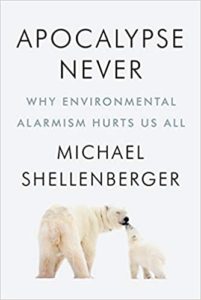If you read Part One of this series of articles still appearing at cfact.org on the shocking reversal of one of the nation’s leading global warming and environmental alarmists you know that his new book Apocalypse Never released this June is receiving immense well warranted attention. Michael Shellenberger spent a quarter century scaring people with the gloom and doom stories you know so well. Somewhere along the way, in recent years, he must have learned of the scientific method of evaluating data, to learn what was really going on. He also learned of the intentional duplicity of most green groups.
While I fault him for his earlier mistakes, I welcome him into the realm of reality, teaching science and its impact on  mankind. He set about seeing the real problems of the world up close and personal traveling from place to place. He learned that the apocalypse promotion of the left was a political movement not an effort to solve the Earth’s problems or the unfortunate plight of those mired in poverty.
mankind. He set about seeing the real problems of the world up close and personal traveling from place to place. He learned that the apocalypse promotion of the left was a political movement not an effort to solve the Earth’s problems or the unfortunate plight of those mired in poverty.
We know many years ago Patrick Moore, co-founder of Greenpeace recognized his organization had been hi-jacked by the left and became a great warrior for real environmental protection. We know that recently leftist Michael Moore did us a great favor with his movie Planet For The Humans exposing the fraud of the idea that the world could run on wind and solar power. It is possible that Mr. Shellenberger’s conversion to the right side of science and his widely quoted “mea culpa” for past sins for promoting misinformation, will be an even more important contribution to our nation and those abroad.
I will quote it again here “On behalf of environmentalists everywhere, I would like to formally apologize for the climate scare we created over the last 30 years. Climate change is happening. It’s just not the end of the world. It’s not even our most serious environmental problem”, said Shellenberger.
It would have been even better had he revealed that Mankind has nothing to do with the planet’s thermostat. He is not there yet, along with the many Luke warmers who, though they can not pin down any real impact we have on the world’s temperature, they refuse to default to the most relevant number which is zero.
Further Shellenberger says “Once you realize just how badly misinformed we have been, often by people with plainly unsavory or unhealthy motivations, it is hard not to feel duped.” Among the best worded explanations for what the world has experienced in these past three decades of environmental fraud is expressed in a paragraph early in his 6th chapter.
“The story of a small band of committed nature lovers saving the environment appeals to us. It is the story we learn from TV and movie documentaries, books, and news reports. It is an exciting drama with obvious heroes and villains. On the one side there are greedy, cowardly people destroying nature for profit, and on the other side there are idealistic, brave youths. It is a story that has inspired millions to take action. The only problem with it as a guide for protecting the environment is that nearly everything about it is wrong.”
In Apocalypse Never, he spares none of the do-gooder pretenders, exposing their ignorance and lies, while being kinder to them than many of us would be.
Shellenberger, with unknown financing, decided to see the environment up close and personal in 2015. First he traveled to Congo, Rwanda and Uganda before going to Indonesia. There he met a 24 year old Indonesian journalist who went by the name of Ipeh. She set up interviews with factory workers who told a very different story about the difficult working conditions screamed about in opposition to Nike in the US. These factories played very important roles in lifting the economy and standard of living in Indonesia. History tells us that most developing economies transformed themselves through manufacturing.
Poor nations can become as efficient as rich nations in making things. Goods made in factories are easy to sell. Factories are labor intensive which allow them to absorb large numbers of unskilled workers.
It all ties back to energy Shellenberger tells us with interesting statistics. The average Congolese consumes the energy equivalent of 1.1 kilograms of oil per day (1.1kg/day), while the average Indonesian now consumes 2.5 kg/day. In the US we consume 19 kg/day.
Contrary to what many believe Shellenberger learned that the positive impacts of manufacturing outweigh the negatives. He says we should thus feel pride not guilt when buying products made in these countries.
Shellenberger got very comfortable exposing misinformation if not out and out frauds. These include the movie Gasland that tried to show hydraulic fracturing to capture natural gas to be hazardous, entirely through lies. More gently he admitted to having been a vegetarian for environmental reasons till he learned he was contributing nothing to environmental welfare and having less energy in the bargain. Better yet was his exposure of the vegans who dwell on poor treatment of animals and erroneously claim negative impacts of eating meat. The authors research on this issue is meticulous.
How many readers would ever have known that McDonalds hired the world renowned animal behaviorist Temple Grandin to advise them on how to treat animals in a manner that makes them most relaxed and happy, because happy animals also grow healthier.
One of the few areas Mr. Shellenberger capitulated on early in his environmental activist’s career was his opposition to nuclear energy. In a brilliant 30 page chapter of his book he summarizes where the world has been on the issue, where it is now and where it should be. He opens the chapter with the March 11, 2011 Fukushima disaster. Hours later I was called to a CNN TV studio to explain what really happened and what would happen. I had just edited The Encyclopedia of Nuclear Energy introduced that month by publisher John Wiley &Sons.
When I explained that due to wind currents and the amount of escaping radiation no one should be sickened or die from the radiation, I was paired with an anti-nuke person on 23 network TV shows in the next 3 weeks. I got hate mail and death threats for the next 3 years. I am sure my readers remember the fear spewed out over it for years. You may not know that no one got radiation sickness or died. However as a result of moving elderly sick people miles away from their homes near Fukishima it is estimated that 1600 premature deaths did occur.
Shellenberger now has an understanding of the wonders of nuclear power clear and accurate. The exception he, like most, still believes eventually fusion of atoms will become a source of commercial energy. Einstein, who I knew at Princeton, thought it was 50 years away in 1954. It is still 50 years away and unlikely ever to be achieved.
In the final part of this chronical of Shellenberger work in recent years, you will learn of the truly evil web woven by the most prominent environmental non profit groups.
